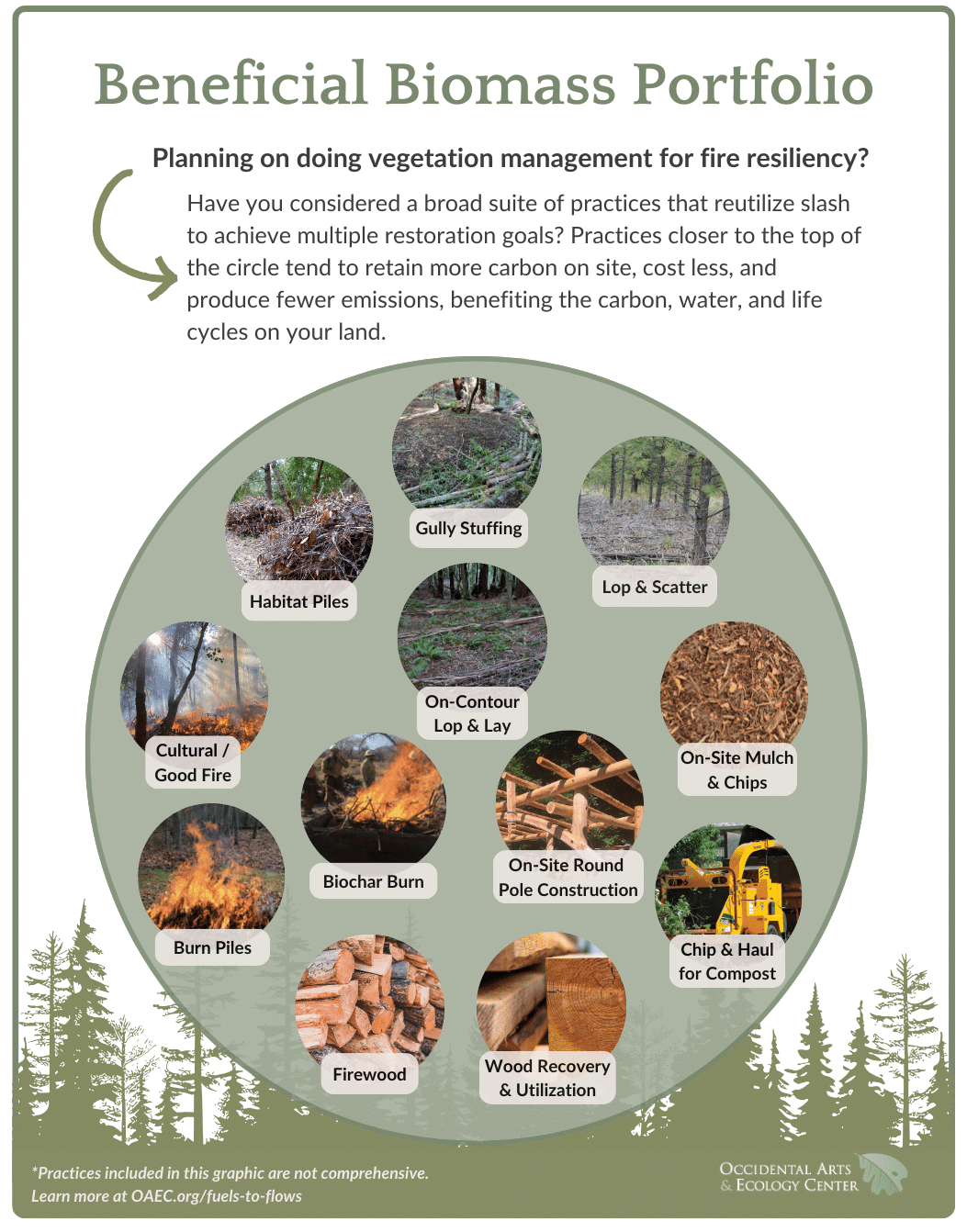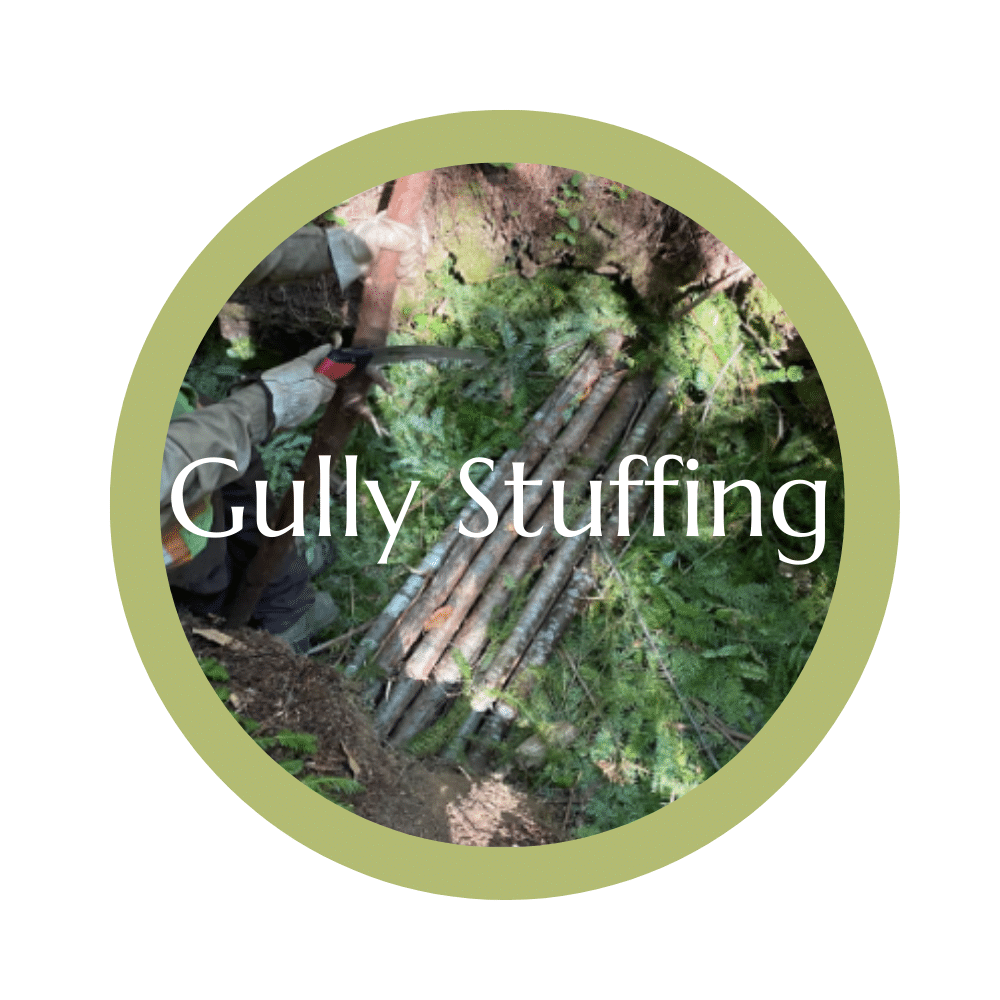Fuels to Flows
OAEC’s Fuels to Flows Campaign advances climate-smart, nature-based restoration solutions at the nexus of fire and water.
“Slash ain’t trash, it’s beneficial biomass!”
-Brock Dolman
The legacy scars of extractive land use and colonization in California have left our watersheds in dire hydrological condition and vulnerable to catastrophic wildfires. Large-scale statewide efforts to reduce fuel load from our forests generate millions of tons of woody “slash.” Currently, the standard practice is to burn it, haul it away to processing facilities, or dispose of it through other fossil fuel intensive means.
What if we could use some of this abundant material to heal erosion, build soil, increase water storage capacity, and support biodiversity? OAEC’s Fuels to Flows Campaign calls for reintegrating these “fuels” into the “flows” of the carbon, water and life cycles. We promote low-tech, process-based restoration techniques through innovative demonstration projects and workforce development trainings with landowners and managers, restoration practitioners, agencies and organizations.
Balancing the Biomass Budget
The massive amount of organic material being produced by vegetation management and defensible space work is a valuable resource that can be used to address other pressing ecological challenges such as drought, flooding, habitat loss, erosion, climate change, etc. Though appropriate in certain situations, releasing this carbon into the atmosphere through large-scale burning, hauling, or industrial processing should be a last resort. Whenever possible, we should consider a broader, more holistic Beneficial Biomass Portfolio and look for ways to retain and recycle this material for on-site carbon sequestration, soil-building, water filtration and recharge, and habitat creation.

What to do with all the slash? It depends!
When trying to decide which Beneficial Biomass Portfolio practices to use, consider some of these questions (not a comprehensive list):
- WHERE? Watershed? Ridge, valley or creekside? Steep slope? North or south side?
- WHY? (Goals and Values) Fire resiliency and safety? Water quantity and quality? Emissions reductions? Carbon sequestration? Biodiversity? Culture? Aesthetics?
- WHAT? (Vegetation Type) Forest? Woodland? Chaparral? Grassland?
- WHEN? Land use history? State of ecological degradation and succession?
- HOW? Funding? Permitting? Collaborative partnership or solo?
- WHO? Labor? Just, family-sustaining wages? Worker safety?

Gully Stuffing
Gully stuffing is one of our favorite tools in the Beneficial Biomass Portfolio because of its ability to achieve many restoration goals at once while putting large quantities of slash to good use. This singular low-tech, cost-effective technique has the potential to filter sediment, reduce erosion, enhance habitat, and improve the carbon- and water-sequestering soil sponge of upland landscapes. OAEC Co-founder Brock Dolman is a longtime practitioner, teacher and champion of gully stuffing techniques. Watch our short animated Introduction to Gully Stuffing: A Nature-Based Solution for Fire and Water and the step-by-step How to Stuff a Gully video below!
Fuels to Flows Campaign: Changing the Rules
One of OAEC’s core strategies is Changing the Rules, and in the context of our Fuels to Flows Campaign, this means reducing permitting barriers and increasing funding for appropriately scaled restoration techniques. We engage state and federal agencies to elevate win-win solutions that can help them achieve their ecological goals while meeting their regulatory mandates. Our work encourages the integration of often siloed techniques, practitioners and agencies toward a whole-systems, whole-watershed approach to land management.

Fuels to Flows Resources
- What Is Process-Based Restoration? – Process-Based Restoration from Ridgeline to Reef
- Gully Stuffing Technique
- OAEC’s step-by-step video on How to Stuff a Gully
- OAEC’s animated video Introduction to Gully Stuffing: A Nature-Based Solution for Fire & Water
- Sonoma County Regional Parks Collaboration
- Tending the Land for Fire Resilience in Sonoma County website resource
- NBC Bay Area news clip on Fuels to Flows
- Why We Can’t Have Fire Resiliency without Worker Justice?
- CalPBR – California Processed-Based Restoration Network – A hub for restoration practitioners and professionals

CalPBR Network’s “Build Like a Beaver” Training 2024 in Plumas National Forest. Photo by Brock Dolman.






